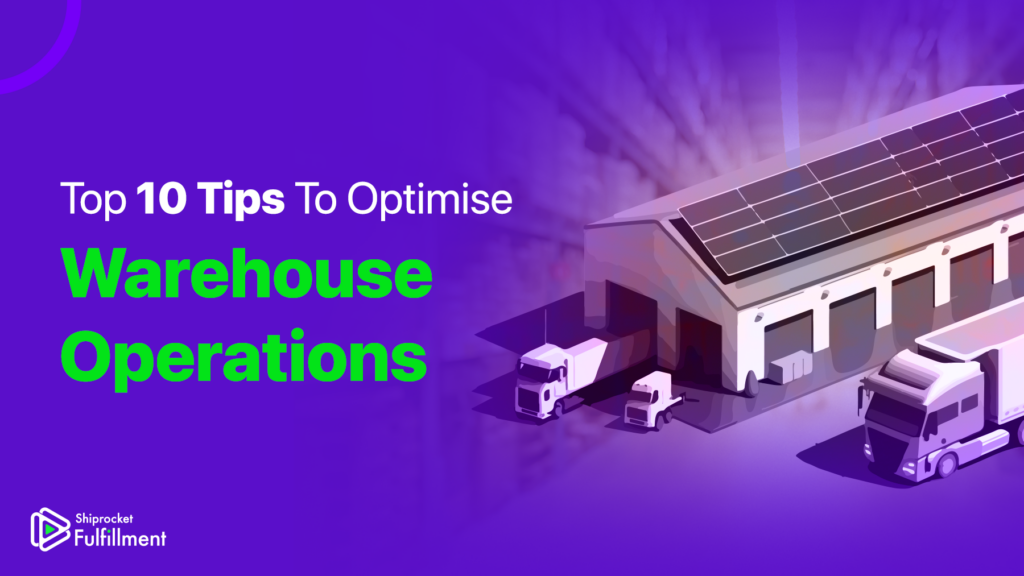Efficient warehouse operations often define the success of eCommerce businesses. Activities such as inventory management, order processing, fulfillment, and staff management can impact customer satisfaction, order accuracy, and overall profitability. The complexities of such operations can be avoided by choosing solutions that solve such needs and yet keep to your budgetary outlays. Collaborating with third-party service providers is one key solution that positively impacts the bottom line for most businesses. Such solutions are driving efficiencies and producing high ROI.

Let us explore the top 10 tips to optimise warehouse operations and discuss how third-party players like Shiprocket can help your business grow with their cutting-edge logistic services.
How to Manage and Improve Warehouse Operations
By implementing the following tips, businesses can improve efficiency, reduce costs, and gain a competitive advantage in the marketplace.
1. Optimise Warehouse Layout
A well-designed layout ensures that products are stored and retrieved quickly and efficiently. Utilise software to design an efficient layout that includes the most frequently accessed products closest to the shipping and receiving areas.
2. Use Technology
Automation is key to streamlining warehouse operations. Use Warehouse Management System (WMS) with ERP or TMS to streamline operations, order fulfillment, inventory management, and shipping. Use other technologies for the optimisation of the process –
WMS for Picking items – This refers to the automated selecting and retrieving items from a warehouse to fulfill a customer’s order with WMS.
Barcode scanners – Optimise the speed of picking items in a warehouse accurately. Each item in the warehouse is assigned a unique barcode scanned by the employee picking the item. The WMS software then verifies that the correct item has been selected and updates the inventory in real-time.
RFID or short-signalling – To attach items in the warehouse using RFID readers to automatically detect and track the movement of the items. Activated picking systems are another technology used with WMS to improve the picking process. The employee confirms the pick by speaking into the headset, and the WMS verifies the correct item picked.
3. Efficient Inventory Management
Accurate inventory counts and an inventory management system that tracks items throughout the warehouse are essential for efficient operations. A recommended practice is tracking software for instant real-time inventory visibility, lower stockouts, and similar risks.
4. Implement Lean Principles
Utilise lean principles such as just-in-time inventory management, continuous improvement, and waste reduction to identify and eliminate waste. Measure parameters for efficiency and work on areas that need improvement.
5. Employee Training
Programs that improve the efficiency and competency of employees should be the primary focus of staff training. Provide regular training sessions that teach them how to use technology and streamline their workflows. Encourage them to share their ideas for improving warehouse operations and reward them for their contributions.
6. Use Data Analytics
Analyse data to identify bottlenecks, inefficiencies, and opportunities for improvement. Use data to optimise warehouse layout, inventory management, and picking processes.
7. Delivery picking
This stage has to be optimised for accuracy and efficiency improvement. A recommended solution is the automation of delivery pickup and route optimisation.
8. Cross-Docking
Transfer the delivery directly from the receiving bay to the shipping bay. This will lower the time needed for handling and processing and the time the product is in the warehouse.
9. Utilise Vertical Space
Efficient use of vertical space can increase storage capacity and reduce the need for expansion. Consider using mezzanine floors, vertical racking systems, or automated storage and retrieval systems (ASKS).
10. Maintain Equipment
Equipment downtime can disrupt warehouse operations and decrease productivity. A structured and systematic way to maintain equipment is round-the-clock programs that regularly service the equipment to prevent downtime.
The above tips will optimise warehouse operations in any industry, giving businesses a competitive edge.

Outsourced Warehouse Operations: Six Ways Businesses Can Benefit
Third-party warehouse operations providers offer several benefits to businesses:
- Cost Savings: Third-party warehouse operations providers have the expertise and resources to manage warehouse operations efficiently. By outsourcing warehouse operations, businesses can reduce the need for additional warehouse space, labour, and equipment, resulting in cost savings.
- Scalability: As a business grows, its warehouse operations must scale accordingly. Third-party warehouse operations providers can easily accommodate increased order volume without experiencing bottlenecks or delays.
- Expertise: Third-party warehouse operations providers have extensive experience in managing warehouse operations.
- Technology: Third-party warehouse operations providers have access to the latest technology and equipment, such as Warehouse Management Systems (WMS) and automated picking systems, which can improve efficiency and accuracy.
- Focus on Core Business: By outsourcing warehouse operations, businesses can focus on their core business areas.
- Flexibility: Third-party warehouse operations providers can quickly adapt to changing customer needs and trends. They can adjust to changes in demand and inventory levels, which can help businesses stay competitive in the marketplace.
Third-party warehouse operations providers offer businesses several benefits, including cost savings, scalability, expertise, access to technology, the ability to focus on core competencies, and flexibility. By partnering with a third-party warehouse operations provider, businesses can improve efficiency, reduce costs, and gain a competitive advantage.
How Shiprocket Optimises your Warehouse Operations
One solution businesses can use to optimise their warehouse operations is Shiprocket Fulfilment services, a 3PL provider. It offers various services, including warehousing, order fulfillment, and shipping management. By outsourcing their warehousing and fulfillment needs to Shiprocket 3PL, businesses can streamline their operations and focus on other aspects of their business, such as marketing and sales. The advantages Shiprocket can offer your business are:
- Efficiency: An optimised warehouse can streamline operations and improve efficiency, leading to faster order fulfillment and increased customer satisfaction. A well-designed warehouse reduces the time to pick, pack, and ship orders so as to fulfill orders faster.
- Cost savings: Optimising warehouse operations can reduce costs by decreasing the need for additional warehouse space, labour, and equipment. Streamlined operations also reduce the risk of errors and damaged products, minimizing the costs associated with returns and replacements.
- Competitive advantage: A business with efficient warehouse operations can gain a competitive advantage by offering faster delivery times, reducing the risk of stockouts, and improving customer satisfaction.
- Scalability: Warehouse operations can be scaled to match expansion by optimising operations to handle larger volumes without experiencing bottlenecks or delays.
- Flexibility: An optimized warehouse can adapt to changing customer needs and trends. Streamlined operations allow businesses to adjust quickly to changes in demand and inventory levels.
Hence, optimising warehouse operations is essential for businesses that want to remain competitive and provide excellent customer service.
Thus, Shiprocket drives an organisations’ strategy to establish efficient warehouse operations. Businesses can increase productivity, reduce costs, and enhance customer satisfaction by optimising warehouse layout and organisation, implementing accurate inventory management, streamlining order processing and fulfillment, and developing well-trained and motivated staff.






